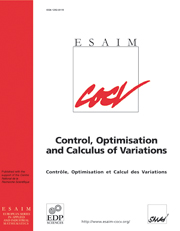No CrossRef data available.
Article contents
A blind definition of shape
Published online by Cambridge University Press: 15 August 2002
Abstract
In this note, we propose a general definition of shape which is
both compatible with the one proposed in phenomenology
(gestaltism) and with a computer vision implementation. We reverse
the usual order in Computer Vision. We do not define “shape
recognition" as a task which requires a “model" pattern which is
searched in all images of a certain kind. We give instead a
“blind" definition of shapes relying
only on invariance and repetition arguments.
Given a set of images $\cal I$ , we call shape of this set any
spatial pattern which can be found at several locations of some
image, or in several different images of $\cal I$
, we call shape of this set any
spatial pattern which can be found at several locations of some
image, or in several different images of $\cal I$ . (This means
that the shapes of a set of images are defined without any a priori assumption or knowledge.) The definition is powerful when
it is invariant and we prove that the following invariance
requirements can be matched in theory and in practice: local
contrast invariance, robustness to blur, noise and sampling,
affine deformations. We display experiments with single images and image pairs. In each
case,
we display the detected shapes. Surprisingly enough, but in accordance
with Gestalt theory,
the repetition of shapes is so frequent in human environment, that many
shapes can even be learned
from single images.
. (This means
that the shapes of a set of images are defined without any a priori assumption or knowledge.) The definition is powerful when
it is invariant and we prove that the following invariance
requirements can be matched in theory and in practice: local
contrast invariance, robustness to blur, noise and sampling,
affine deformations. We display experiments with single images and image pairs. In each
case,
we display the detected shapes. Surprisingly enough, but in accordance
with Gestalt theory,
the repetition of shapes is so frequent in human environment, that many
shapes can even be learned
from single images.
- Type
- Research Article
- Information
- ESAIM: Control, Optimisation and Calculus of Variations , Volume 8: A tribute to JL Lions , 2002 , pp. 863 - 872
- Copyright
- © EDP Sciences, SMAI, 2002




